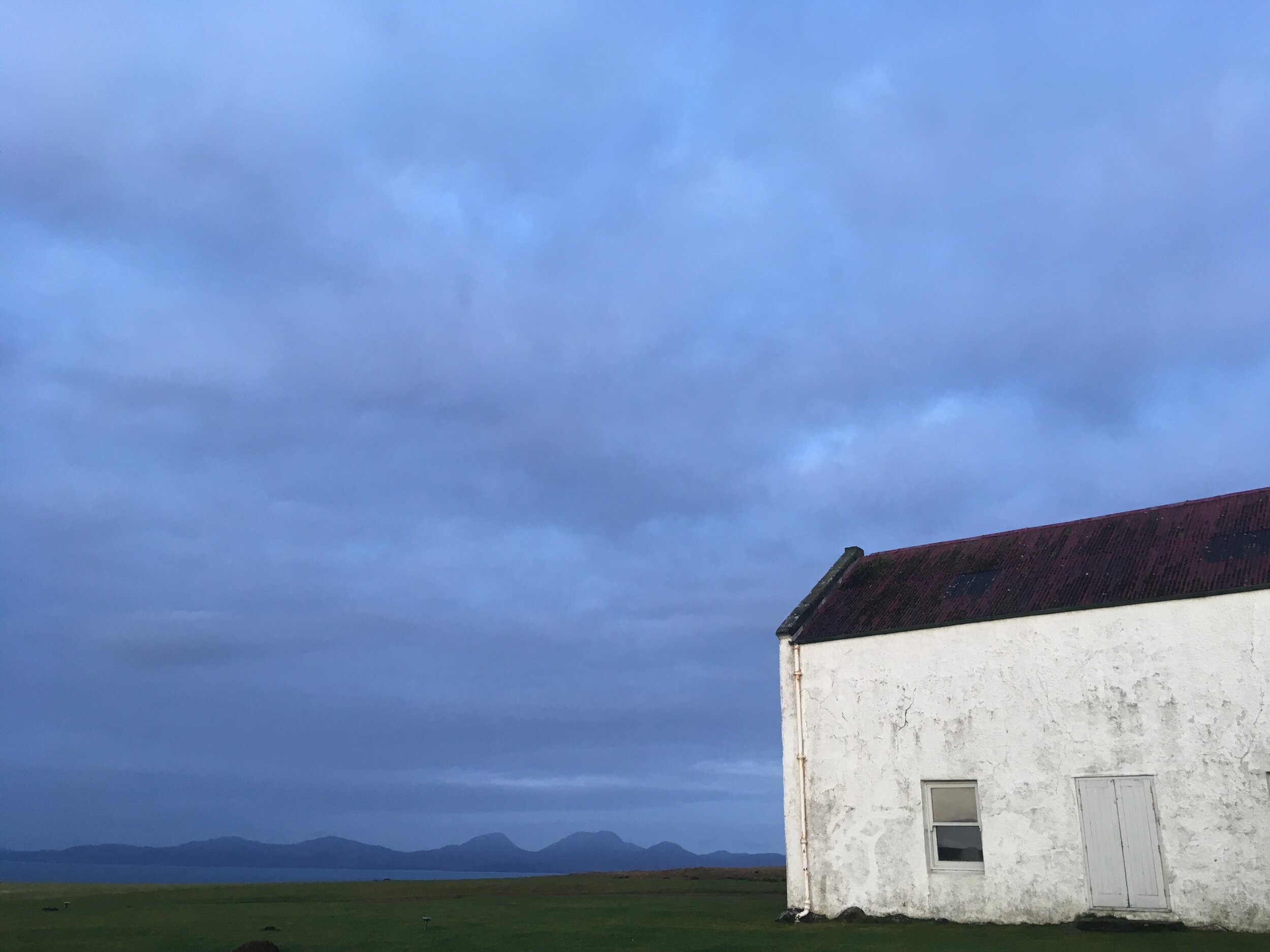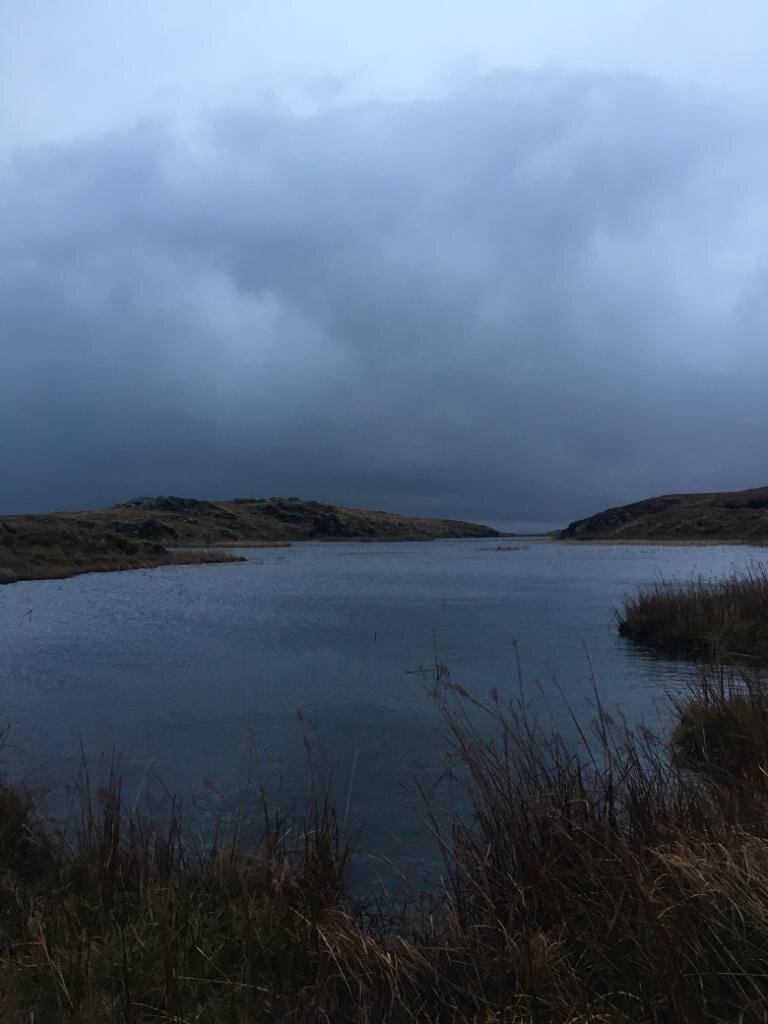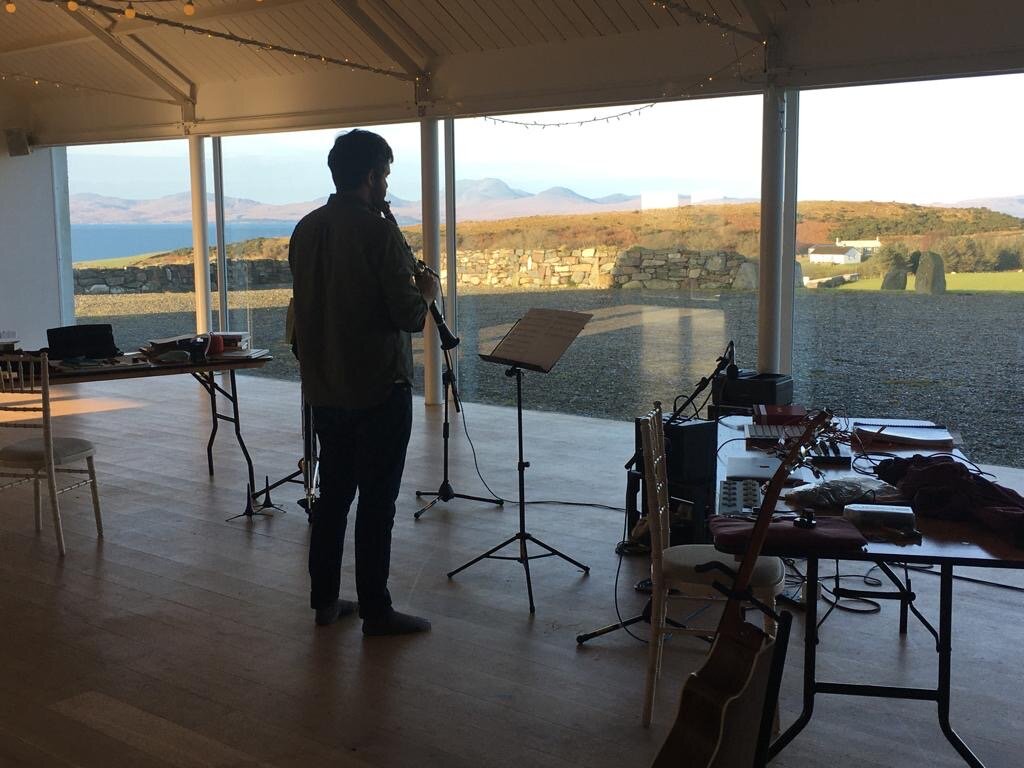Writing music by the Sound of Jura
Shearwater
A short winter residency
Transmission Fund
Help Musicians UK is an independent UK charity for professional musicians at all stages of their careers, they help at times of crisis, but also at times of opportunity.
I was recently awarded their Transmission Fund, a grant that funds opportunities that focus on developing your creative practice and furthering your professional development at a crucial point in your career. The award came at a time when I’d moved home up to Cumbria and was juggling work commitments, long commutes, getting my head around a new life and struggling to find time to write the music and focus on the projects that were just catching light.
I used the Transmission Fund to steal away to the west coast of Scotland - not the shortest commute I know, but this time to stay put for the best part of a week - the edge-lands there have been a source of inspiration and energy for me over the years, it’s a place where I know I can focus.
My wife Sophia and our curious Border Terrier were able to join me, so we all jumped in our blue van (Bonnie) that I’d spent the day filling with everything I could think I might possibly need, and drove up over Shap summit into the chilly winter night sky. Five hours later we were skirting around Loch Fyne and pulling off down a long single track road with deer making jumpy appearances, the coal-black Loch Caolisport burbling off to the right somewhere. Then suddenly, when we’d lost sense of how far we might have driven, a long tablet of bright light on our left that was such an unexpected sight that I nearly drove off the road. We were at Crear!
The weather wasn’t stopping, we’d wandered open-eyed around the beautiful barns, studio space and old cottage turning off the lights as we went before we unpacked the van in the wind and rain, shifting all the gear into the studio ready for the next morning, wondering what we’d see from the huge windows.
Day 1
crear
Woke up and caught the first glimpse of shadowy Jura through the loft window, it was already light in the studio. I went outside and filled my lungs with the place, feeling my whole body relax and my head instantly clearer - you couldn’t see that far, the late arrival had meant I’d slept longer than usual and by now the mist had obscured much of the middle distance.
The buildings sat half-way up a track which led into rusty brown hills or down over a rise to the sea. Sheep and grazing land either side, with forestry work going on to the south east. A car arrived and Julie from the Crear team met me with a smile and lots of energy, her colleague Fiona joined shortly after, both making the commute from Lochgilphead. After introductions over breakfast, a tour with instruction on how to turn the various (and very loud) alarms off, and a hilariously sketchy exploration of the wifi in the loft, we were left to our own devices.
I finished unpacking everything, making a guess as to how I’d want to use the studio space, facing out optimistically towards the Sound of Jura. I had a table for thoughts and a table for actions, the thoughts table table had already spilled over into the kitchen… I figured that if I got everything out and plugged things in, that I’d need to confront it all at some stage. I wrote a list on the first page of my journal, a collection of ideas I was hoping to look through while I was there, or at least discover they didn’t need looking at. Then we went for a walk, eager to make the most of the light.
Down the track past buzzards, crows and murmurations, across grasslands to Cretshengan Bay. The beach gave a hazy view of Islay, Jura and Gigha, where my ancestors are buried. It is so beautiful here and this was the first time we’d been to this coast in the winter, the light was frozen and mysterious. Huge round stones on the beach, patterns like constellations in the rock, mosses and sand routings. Some driftwood from the hull of an old boat and a quartz hagstone.
Cretshengan Bay
A burial chamber watched over by fishing boats and fishing birds, huge oystercatchers, gulls, terns, shags and kittiwakes. We sat by the sea for a while and then tramped back as the rain started picking up to make a hearty lunch.
I started with the bass clarinet, the studio has a clean but generous acoustic and it felt good to make some noise, to break the distant sound of the wind outside. Fiona left about four o’clock, the light had all but gone and I set about one of the least attractive tasks of the residency - trying to understand the user manuals for a couple of the controllers I’d brought with me to use with Ableton Live. My friend Aaron Diaz, a fantastic trumpet player and someone who works a lot with different live processing, had said that you just have to sit down and dig in for a few hours. I’ve spent most of my time since I was a student focussing on the acoustic properties and possibilities of my instruments. Various projects have involved the use of live electronics but usually with parameters set by the composer, the technician or the technology. Interfaces can often feel clunky, over-bearing or unsubtle as a performer in these scenarios. Certainly in the classical scene, my feeling has been that the use of technology is often perceived, even unwittingly, as a compositional crutch or replacement for an otherwise achievable acoustic technique if you were only willing to practice longer or think a little harder. I don’t believe this.
ABLETON
I think that as musicians with any imagination on our instruments, we are missing out by not engaging with the increasingly intelligent, nuanced and incredibly powerful sonic tools available, and that if you can set your own parameters based on musical necessity rather than technical limitations the possibilities right now are very exciting.
Aaron was right, and after a few hours I’d made some real headway. Enjoyed simply playing some of my favourite repertoire in the space and even some songs with Sophia. After dinner I went back to improvise along with the whole of Caoimhín Ó Raghallaigh and Thomas Bartlett’s recent album, trying to ease out the improviser and writer in me, it felt like a release. Ó Raghallaigh plays a 10-string fiddle called the hardanger d'amore, and for years now I’ve been obsessed with the sounds this instrument can produce, intrigued by how close it can get to breath and a lot of the sounds I’m also interested in making as a clarinet player. I play a lot with string players, often performing quintets and really enjoy writing for them in my group Propellor. Ever since I was a student I’ve felt like being a musician rather than an instrumentalist alone, was to listen to what we all have in common.
We walked out up the track towards the hills, watching the bowl of stars above and a shooting star straight ahead.
Day 2
I got up earlier, before dawn (not so hard in the winter!) and started by writing my journal of the day before at the kitchen table. It was a little clearer outside today, the fishing boat that seemed to remain in one place ahead of the kitchen window was blinking its light at the house. Filled up on coffee, porridge (with a little whisky to start the engines) and tucked into re-reading a book that I am starting to write some music for. The author has become a friend and together we hope to do something new with the text. I’ve been inspired by spending the summer as part of the team for Tao of Glass at Manchester International Festival, a new theatre piece with puppetry, new music by Philip Glass and the work of actor/director Phelim McDermott with Kirsty Housley also directing. The experience re-kindled my love for theatre, and followed on from projects like When I Die and Danserye which I had enjoyed so much, bringing me round to the realisation that there’s no reason why I shouldn’t try to make something happen myself. I read until I’d finished the book and the coffee had gone cold.
Back in the studio I sat down with the Caoimhín Ó Raghallaigh and Thomas Bartlett album again, loving the freedom of improvising in the space the duo had left in the recording and ironically I suppose, filling it in. Afterwards I definitely had the sense of an itch being scratched, and that I was ready to start playing my own music now. After lunch we headed out to make the most of the daylight hours and see the Loch which Crear draws its water from, nan Torran. The weather was giving it some, pouring and windy. A herd of sheep followed us up the track into the gloaming. Soph was feeling intrepid in the high winds and shot off the track to take us to the smaller Loch Eun, electric blue with underwater flocks of bird shadow blown by the movement of the wind. The wind was so quick in the way it skimmed the surface it made this tiny pool look like Coniston on fast-forward!
Loch Eun
Soph wanted a swim and it did look inviting, but it was baltic-cold, the night was drawing in and Jaz was shivering so we walked back over the peaty tussocks to the path and came down the hill, our eyes had adjusted and we didn’t need the torches we’d brought.
Back at the house we dried off and got warm. I called the writer and we had a good catch up, lots of ideas and insights into how she had come to the stories, and where we would take it all next. Then I started writing on the clarinet, a strange quarter-tone song with lots of timbral shifting, the sound of the gloam we’d walked through. After dinner I was back in the studio, this time writing on the bass. I wasn’t writing with anything particular in mind but just wanted to see what came out, it was a slow song in 6/4, echoes of the 17th century music I’d been listening to that morning and the Scandinavian music I felt closer to up here. Then I re-opened an Ableton session called Shearwater that I’d written a year ago for a friend’s solo concert series in London. It had felt a little out of place down there but I still liked it here - closer to the Shiant Isles where Adam Nicolson had been inspired to write about the seabirds I’d named it after. I was excited to see how I could develop the piece while I was in a wilder place.
I gave in to some admin late that night, some news about shifting plans in the year ahead and not as many stars out along the track.
Day 3
Woke up early and eager to get on, a fantastic view of the Paps of Jura greeted me outside in the cutting air. I was sitting at the kitchen table again when the sun rose over the forest to the south east, flooding the house with light and giving Islay a warm, rusty glow which dragged me outside again.
Lots of coffee, lots of notes and thinking about priorities. Before arriving, I’d felt my writing would need an injection of some sort to get going but it was actually right there, ready to hook itself to an idea. It was the ideas that needed this time and space. I had come with the main intention of beginning to write for Propellor’s next project, but what I realised was that the nature of the project in mind and its collaborators was very different to how Loom had needed to work, with me writing the material and then working on it with the band. This time the band was a thing in its own right, and ready to write as a group alongside Leafcutter John and Ryan Latimer who are also contributing to the project.
nature of the project
This suddenly gave me a sense of freedom. I realised that what I’d come to do was develop as a musician, to write new music, learn new skills and examine the way I was working so that I could decide which tools were useful and interesting.
After an hour or so of playing, we headed out once again to make the most of the day, walking down the road a little way and then along a farm track to some beautiful pebble beaches. Soph went off to find a place to swim and I started hopping between the rocky outcrops nearby looking for inlets and eddies where I could use my hydrophone to get some good recordings of underwater sounds. I’d forgotten my headphones so had to guess based on the recorder response whether I was going to hear anything later, most were duds but I did get one long stretch of uninterrupted Jura Sound. We carried on around the coast, the sun was blindingly low as we made slow progress on the scrubby ground, which the deer who looked on from the bushes above had obviously mastered.
To KIlberry point
This traverse went on for some time before a track up on the left took us to the top of the little cliff. A herd of cows on the shore below us now at Kilberry Point and an ancient path into a box of woodland concealing a walled garden, the domed and turreted Kilberry Castle and huge numbers of Victorian rhododendrons. An elderly couple seemed to be managing the estate and left us to our wandering. We saw the ancient Kilberry Stones with illustrations from a long time ago, the whole place felt strangely forgotten about. A sunlit walk back along the road, the sky catching fire with purples, pinks and oranges before dying away quietly behind a long line of cloud.
Back at Crear and to writing, a quicker tune on the Bb, layered up with a second time signature, I was writing fast. Enjoying using Ableton to explore new sounds and layer ideas easily, it’s a good composition tool, it doesn’t get tired. I was also practicing Shearwater, I wanted to try and get a clearer recording of it the next day. Then a quick dive into the collection of books I’d brought with me from the library, books about structures, underground structures and the lives of creatures and subterranean UK. It’s fun to dip into numerous texts at the same time, I had books on physics, insects, mining, the future of our planet and then on listening, on soundscapes and collecting. It was too much obviously to take in, but enough to get a sense of what it was that had made me group all of these together in the first place. They’d been gathered quickly, gut feelings, and so now I got a little further into those ideas. I was thinking about Propellor and how we needed to tell a new story in the next piece, a story about time, collective mark making and interaction, intervention, choices. The piece was already formed in my head in one sense before coming to Crear in that I knew who I wanted to work with on it, and IT would be a dystopian folk opera where the audience had a direct impact on the sonic environment they found themselves in…
I wrote out the bass music so it was legible and then we had dinner, fell asleep by the fire feeling much more tired than I’d thought. Back to the bass for an hour but nothing new, so it was time to go out for another look at the incredible stars. We saw a three second long burning star, a bright dot plummeting straight down in the north, incredible high streets of lights up there.
Day 4
Woke up early again to an amazing view of Jura through the panoramic studio. I quietly got a coffee on the go and sat down at the small table to make notes. The sun came up over the forest and I wrote out the whole of Shearwater properly at last (a year after I’d started) before breakfast.
the last day
In the studio I quickly finished the last of the transcriptions with the help of my trusty melodica for quick reference. Then I set up to record all the material I’d been writing and that’s what I did. Slightly frustrated that I still hadn’t got the foot pedal to speak to my laptop in the way I wanted it to, I also decided that a DPA 4099 mic was going to be the ticket for doing any of this live so that’s gone on the wish list…
I’m going to make a solo album in 2020. That’s what I realised as I recorded these different pieces. That felt like an outcome, a decision to do something I hadn’t done before, a conclusion to having started writing Shearwater a year earlier.
Sunlight poured through the studio and the whole day I felt sorry to be going. We said goodbye to Fiona and then drove off down the road towards the sea, took a right and hot-footed it to Glasgow to catch an old friend for dinner there. It already felt a bit like a dream, but that’s how I feel about the Scottish coastline every time we have to leave, and we’ll be back.
Thank you to Help Musicians UK. To Kate, Julie and Fiona at CREAR. To Sophia and Jaz.









